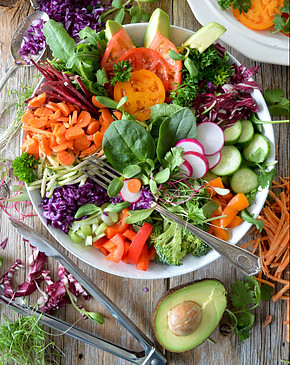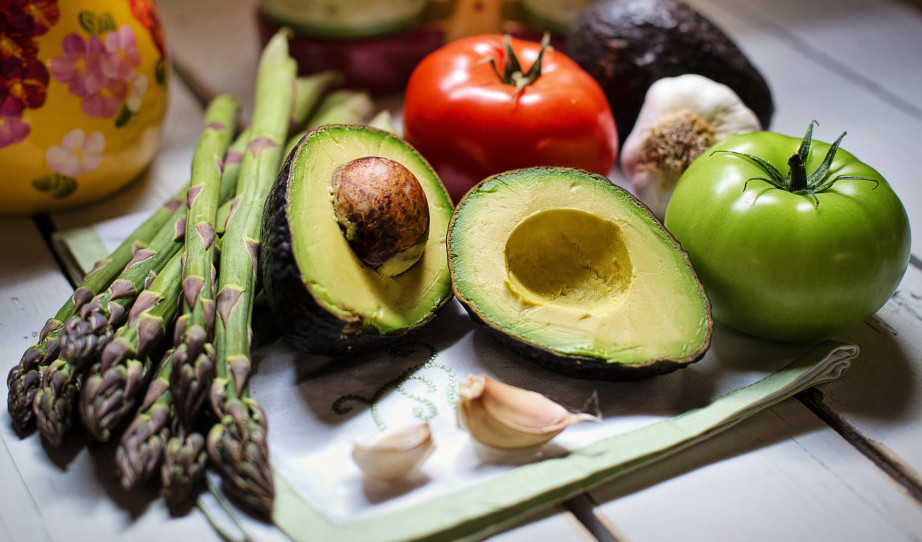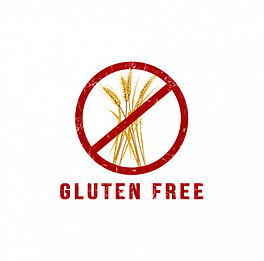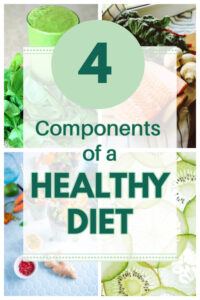4 Components of a Healthy Diet
“Food as medicine” is one of the core foundational elements of natural health and healing, as the food that we eat plays a tremendously important role in our health.
tremendously important role in our health.
When it comes to one’s diet, adhering to your unique bioindividuality and specific subjective physiological needs (such as your hormone imbalances, genetics, mineral imbalances, gut imbalances etc) is of the utmost significance.
However, there are 4 components of a healthy diet/eating plan that can be implemented by most which we will explore in this article.
1. Low in Sugar
Consuming large amounts of sugar, even natural sugar, can lead to insulin resistance and diabetes, weight gain, hormone imbalances, gut imbalances, neurological imbalances, systemic inflammation, arthritis, heart conditions, dental conditions, skin conditions and much more.
Sugar is also taxing to the liver, kidneys, and pancreas.
Diets that are high in sugar also increase oxidative stress, explained further here.
Furthermore, sugar can be inflammatory. This means that during its metabolism, inflammatory processes can be triggered throughout the body. Inflammation is a normal immune response, however when it becomes chronic, it can have a very adverse impact on one’s health in many ways.
Your body basically treats sugar as though it were a stressor, especially when you have an existing health condition or physiological imbalance of some kind. This stressor has a very detrimental impact on your body’s ability to maintain homeostasis and balance.
When sugar is consumed, the body releases the hormone insulin, which helps the sugar to enter your cells to be utilized, taking it out of the bloodstream and maintaining blood sugar balance. When a high amount of sugar is consumed regularly, the pancreas will produce more and more insulin, but your cells become less and less sensitive to it and the sugar has a more difficult time entering the cell, so it starts to build up in the blood. This is called insulin resistance.
Insulin resistance can lead to a whole host of health challenges such as PCOS, weight gain, high blood pressure, and more.
Furthermore, sugar is the main food source of many pathogenic microbes such as fungus, bacteria, viruses, and parasites. Diets that are high in sugar will lead to various infections, especially gut imbalances and infections, as these microbes are able to flourish and proliferate given the high levels of sugar consumed.
Sugar cravings are often the result of an existing gut infection, due to the fact that the primary food source for the pathogens is sugar. As you balance your gut, in part by reducing the sugar in your diet, these cravings will usually diminish.
The state of our bodies and our environment is not what it was a century or two ago, hence our inability to simply convert sugar to energy as it was originally intended. Our bodies have a very high “toxic load” to manage on a daily basis already, and adding too much sugar to this load really rocks the boat even further.
Reducing the consumption of sugar is a super important factor to consider when adopting a more healthy and healing way of eating.
Once you do this, and you start to experience how much better you are feeling as a result, sticking to your new low sugar eating plan will be much easier.
eating plan will be much easier.
Rule of thumb: When it comes to any food item that is not a whole food (i.e. fresh produce, fresh meat, fresh seasonings, etc) assume that it contains sugar. Reading labels is very helpful, as most conventional food items that are packaged contain sugar, even if one would not assume so. Bottled sauces and dressings, for example, contain loads of sugar.
Bottled drinks such as juices and soda also contain high amounts of sugar.
Common names for sugar on labels include:
- dextrose
- fructose
- glucose
- maltose
- lactose
- sucrose
- cane juice
- high fructose corn syrup
- and more
The lower the amount of sugar on the label, the better.
2. High in Mostly Whole Foods/Low in Processed Foods
Chemically processed foods are extremely common yet have very little nutritional value and can also be detrimental to one’s health.
Chemically processed foods include items such as fast food, frozen “ready” meals, packaged baked goods, packaged breads, conventional boxed cereals, snack foods such as chips and candies, processed cheese items, processed meat items, sodas, and more.
These “food” items often contain a large array of added artificial ingredients (such as artificial flavorings, colors, etc), preservatives, texturing agents, sweeteners, sugar (often in the form of high fructose corn syrup), and artificial trans fat.
Artificial chemicals are essentially toxic to the body, especially when consumed in excess. Sugar is as well, as explained above. These ingredients can also trigger the immune system, creating a state of chronic inflammation, which has a very negative overall impact on our body’s organs and systems.
above. These ingredients can also trigger the immune system, creating a state of chronic inflammation, which has a very negative overall impact on our body’s organs and systems.
Artificial trans fats are created by an industrial process that adds hydrogen to liquid vegetable oils in order to make them more solid. These are most commonly labeled as “partially hydrogenated oils.” This form of fat is inflammatory to the body, adversely effects heart health, catalyzes blood sugar imbalance, and raises your LDL cholesterol, which is considered your “bad” cholesterol.
Wonderful alternatives to trans fats are “healthy fats” such as coconut oil, olive oil, and fats found in nuts, seeds, and avocado. These fats are referred to as monounsaturated and polyunsaturated fats. Coconut oil is considered a saturated fat which isn’t as optimal as mono or polyunsaturated fats, but it is ok in moderation.
Overall, consuming artificial, processed foods, especially on a regular basis, creates much more work for your body and plays a large role in the development of many health conditions.
The goal is to nourish your body as opposed to burdening your body.
You want to focus on foods that are minimally processed, and if they have been processed, that it is a form of mechanical processing vs. chemical processing. For example, a meat item that has been ground vs. a meat item that contains nitrates, artificial preservatives, and coloring.
Some examples of whole food options are:
- vegetables
- fruits (while being mindful of sugar content and focusing more on lower sugar fruits such as berries)
- good quality meats and poultry
- good quality eggs
- wild caught fish
- nuts and seeds
- fresh or dried seasonings
- fats from olive oil, avocados, etc
Again, bioindividuality is of huge importance so everyone’s diet will differ depending on their unique needs.
Aiming to include a rainbow of colors can be helpful in making sure you are including enough variety as well.
Dairy is particular to your unique needs, like all aspects of your eating plan are. Dairy can be inflammatory, so this is good to remain aware of. If one does include dairy, organic is preferred, as conventional dairy is much more likely to contain hormones, antibiotics, and synthetic chemicals.
to remain aware of. If one does include dairy, organic is preferred, as conventional dairy is much more likely to contain hormones, antibiotics, and synthetic chemicals.
Rule of thumb: stick to the outside circumference of the grocery store when selecting your main food items. Usually, this is where the whole foods will be found.
As you gradually reduce the amount of processed food in your diet, your inclination to reach for these items will decrease, and your taste/cravings for them will also begin to diminish.
You can really feel the difference in your health when your body is being fueled with real food vs. artificial chemicals which certainly serves as an impetus to keep eating mostly whole foods!
3. Low to Moderate Amounts of Grains
There are 4 main reasons that low to moderate amounts of grains are recommended on a healthy and healing eating plan.
First, most grains are very high in carbohydrates. Carbohydrates catalyze spikes in blood sugar which is not good for your hormone balance nor your body’s overall homeostasis in general.
Second, most grains irritate the gut lining. Maintaining the integrity of your gut lining, also called your gut mucosa, is of extremely high importance in your healing.
extremely high importance in your healing.
Much more on gut health can be found here.
Common elements that can irritate the gut lining include grains, pesticides, prescription antibiotics, some other medications, and pathogenic microbes such as bacteria, fungus, and parasites.
Your gut lining is usually only semi-permeable, with tight junctions that only allow certain small substances through like the nutrients from your food. If the gut becomes irritated enough, these junctions will widen, causing substances that are meant to remain in your intestines to leak into your bloodstream and hence throughout the rest of your body.
This phenomenon is called having a “leaky gut” and is responsible for causing a whole host of health issues such as systemic inflammation, autoimmunity, neurological imbalances, hormone imbalances, food sensitives, arthritis, and much more.
Third, grains are high in what are referred to as “anti-nutrients” or “phytates/phytic acid.” Phytates/phytic acids are compounds in certain foods that bind to imperative nutrients such as zinc, iron, magnesium, and calcium and disallow the body from utilizing them properly.
There are certain ways to prepare foods that are high in phytates that can help lower the anti-nutrient content such as cooking, soaking, and sprouting.
Soaking and sprouting is a process that includes soaking grains, seeds, nuts, or legumes in water, rinsing, and then continuing to rinse periodically until they sprout. This process lowers the phytic acid content and also makes them easier to digest.
And finally, grains, particularly processed, refined grains and white flour products such as white bread, pasta, crackers, and cakes are very inflammatory to the body. As discussed above, a state of chronic inflammation contributes to the development of many health conditions and has a notable adverse impact on our body’s organs and systems.
4. Gluten Free
You are likely aware of the gluten free “movement” and may wonder what it is all about. There are very important reasons for avoiding gluten, and they aren’t just pertaining to people whom have a confirmed Celiac condition or something similar.
avoiding gluten, and they aren’t just pertaining to people whom have a confirmed Celiac condition or something similar.
Gluten refers to a number of forms of protein that are found in various types of grains, including wheat, rye, and barley and is often found in food items such as pasta, bread, crackers, and pizza.
One of the main reasons for avoiding gluten ties into #3 on our list. Gluten is very irritating to the gut lining. This is because most people have an inflammatory reaction in their gut when gluten is consumed, which over time will poke holes in the gut lining and widen the tight junctions of the lining, as explained above.
Furthermore, gluten proteins are resistant to the enzymes in your body that are responsible for breaking down and digesting protein, so these undigested proteins end up being released into the blood stream, leading to systemic inflammation and autoimmune responses.
There are loads of ways to substitute gluten in your diet, and more and more options are becoming available today. For example, using flours made from ingredients such as nuts, beans, quinoa, tapioca and many more can be used for anything where a wheat flour would have been.
In addition, more and more restaurants and food manufacturers are making gluten free options a large part of their offerings.
Someone with a perfectly balanced gut can probably handle a moderate amount of gluten. However, the fact is, most people in today’s world have some degree of gut imbalance as a result of a number of common factors including the overuse of prescription antibiotics, diets high in sugar and chemically processed foods, high stress levels, environmental toxins, and more…all of which significantly contribute to gut imbalance.
toxins, and more…all of which significantly contribute to gut imbalance.
Overall, the less stress that is put on the digestive tract, the better, and gluten can create a considerable degree of intestinal stress for quite a large amount of people.
In Closing…
Once more, a “healthy diet” is subjective to the individual per their specific physiological needs, however the 4 components that we’ve explored here can usually be implemented by most people as part of the shift to a more health conscious way of eating.
Regarding organic vs. non-organic foods, you want to aim for mostly organic if possible. It is more important that your eating plan consist of mostly whole foods, so that is your first priority, followed by those foods being mostly organic. There is leeway here regarding traveling and eating out, as it is impossible to know if those foods are truly organic or not.
It is also excellent to purchase seasonal, local produce when possible so look into your city’s farmer’s market schedule. These markets are a wonderful place to find the best seasonal local produce in your area.
Furthermore, it is much more effective in the long run to make gradual changes over time instead of a sudden sweeping change, so be tender with yourself as you make gradual changes.
In time, you will begin to feel the difference, and your body will thank you :).

REFERENCES